Abstract
The article is devoted to the analysis of modern trends in the creation of public spaces in the city of Komsomolsk-na-Amure on the examples of domestic and foreign experience. Various functional features of the public space creation are considered. The distinctive features of the public space creation with the help of architectural techniques based on the use of water devices and modern innovative devices are revealed. Student projects are noted where current trends in the creation of public spaces are expressed. In addition, the author considers various architectural solutions for public spaces concerning roofs and territories of former industrial buildings. Examples of such solutions are indicated and a brief description is provided. Identification of global trends in the improvement and creation of city public spaces and their presentation in students’ graduation projects on public spaces. The concept of public space implies an area that realizes various ideas of the society. Originality/value: A valuable statement in the offered work is the totality of numerous decisions concerning creation of public spaces, as well as the current requirements for this activity. As a result, there has been a sharp increase in the relevance of creating such spaces, which help the city acquire a new model of human activity.
Keywords: Square, landscaping, comfortable space, public space, urban environment
Introduction
The modern trends are the creation and development of public spaces (Miroshnik, 2017). Public space is an environment for communication and social activity, organized in accordance with modern human needs. Such an environment can be a site of attraction and is aimed at solving numerous problems of a person's existence in the urban environment. Therefore, in modern times, architects and designers offer various solutions for openness, accessibility and improvement of public spaces.
The concept of public space implies an area that realizes various ideas of the society. It combines the functions of trade, cult processions, holding public holidays, political debates, education, and catering. The result of combining all these functional characteristics of the area and the urban space where these features appear is the empathy to human needs and the emergence of spaces where a person of any social class can feel comfortable when spending his free time. Therefore, public space is an incubator of urban development. This is the environment for the emergence of new leisure spots.
Problem Statement
This paper explores the development of a relatively new phenomenon in urban planning - public spaces. In the offered work it is analyzed on examples of world experience of their development and implementation. The analysis revealed general principles of their organization, and methods used in their design. The application of the revealed patterns in the development of projects for a specific urban settlement is shown.
A distinctive feature of the public space creation is the human need for relaxation and communication. Existing spaces of the urban environment: parks, squares, etc. are currently undergoing changes and rethinking. Architects, designers, sociologists, and urbanists solve the problem of creating a comfortable and “lively” environment in the city, reducing tension in the socialization of a person, determining ways to influence the existing situation in the city and changing it in favor of the city dweller. In addition, it became relevant to design and create areas that are now not used as public spaces. Abandoned industrial areas, bridges and roofs become a "treasure" in the new urban space creation.
Research Questions
At present, the creation of modern public spaces reminds a bridge between the urban environment and the society. Innovative materials and technologies placed in operation increases the chances of the interworking.
As noted above, public space is an area where everyone can feel the response of the city to their need. It is important to say here that the creation of this connection (a person - a city) is under the scrutiny of scientists from various fields. The evolution of the urban environment, noticed recently, is being set as the impetus for the device and the origin of new semantic and functional loads (Farnaz, 2017).
Purpose of the Study
The following question arises: where is the public space in the city? The answer is any area of the environment (Sullivan, 2017). The human environment is mobile. What we are used to seeing every day based on the needs of a person’s life is justified for us as an everyday urban environment (Barke, 2019). Components of this environment are: a lane, a street, a boulevard, a courtyard, a park, a square, an embankment, city roofs and so on. It is worth noting that the components of the urban environment also have an impact on the habitus of society, the response to what we see. A well-maintained environment gives rise to the development of cultural characteristics of the modern man's consciousness. The arrangement of the environment affects urban culture and society as a whole. Therefore, it is important to preserve the existing basis of urban space and transform it depending on modern trends in the mankind development (Pari, 2017).
Research Methods
Thus, a lane, which previously could cause the unsuccessful movement of a person, is now being designed as an area to relax or read books. Representing a small section of the environment between the objects of architecture, it is landscaped with the help of architectural and design solutions for paving, installation of benches, awnings, lighting fixtures and small architectural forms like art objects, various sculptures and memorials. Public gardens and parks start with outdoor furniture with innovative technologies; squares and embankments obey modern architectural solutions, and courtyard spaces seek solitude and design of places for quiet relaxation. Recently, the improvement of courtyard spaces as a way to solve the safe and affordable location of people in this territory has become relevant in Russia. It also turns out to be new that courtyard spaces are more landscaped, and places of quiet relaxation are arranged. As for sites for active leisure, this type of space is diverted away from residential buildings in order to distinguish between a calm and active leisure time (Grigorieva et al., 2018).
For example, the project for organizing the square at the junction of streets called Vasyanin and Molodogvardeiskaya in the city of Komsomolsk-na-Amure (Figure 01), reflects the improvement of public space near the office building. The territory taken for improvement is a long pedestrian avenue with a small area near the building. So, on an extended avenue, bicycle paths are arranged that do not interfere with the movement of a pedestrian. Benches, lanterns and additional landscaping bring a positive impact on the life of an individual to this part of the urban environment. This is manifested, first of all, in the organization of the environment, and secondly in the creation of new city culture. It can be noted that the project includes a solution of water bodies in the form of separate fountains of a rectangular shape. In addition, a water structure in the form of an artificial lake with a bridge and convenient steps close to the water was arranged on the square near the office building.
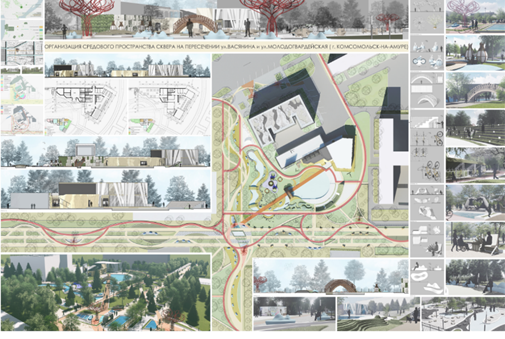
Today's individual “creates” the environment based on his needs, which indicates his interaction with urban space, the search for a response to his willingness to constantly change.
Modern landscaping of the boulevards and pedestrian streets of Western Russia and Europe are well-organized places for walking and various public events. Amenity represents numerous ways of design solutions for laying paving, mobile devices for gadgets, lighting devices, as well as the use and installation of objects of modern art. Seats have various shapes, from round in plan to elongated and curved.
The bridge belongs to the public space and today we can say for sure that this is a new type of public urban space. The bridge can perform the functions of: a shopping street, a street selling arts and crafts, residential buildings, for example, the Kremerbrücke Bridge in the German city of Erfurt; the Parisian Pont au Change (Gelfond, 2015).
Findings
Modern public spaces are being created all over the world in the former industrial territories, for example, students’ graduation project “Commune of Architects, Designers and Artists”. This project is located in the city of Komsomolsk-na-Amure within the boundaries of Kirov-Bazovaya-Puteyskaya streets in the territory of the former battery plant. The appearance of such an object in the city will help create a structure functioning on the basis of generation continuity in the artistic and architectural practice and in the field of various types of design. Concentration of preschool special education institutions, premises of children's art schools, preliminary courses to enter universities, departments or branches of state universities of the city within the framework of art and architectural education and creative workshops of artists, designers and architects will create the prerequisites for a high-quality urban environment and the formation of a new worldview of society based on an aesthetic and emotionally rich perception of the environment.
The social relevance of the development of urban public spaces is also manifested in the design and improvement of urban squares. This is due to an increase in social activity of the population, which creates the need for new spatial forms.
Historically, the southern region of Philadelphia has been characterized by wetlands and meadows, which previously housed urban marinas. Currently, this area is becoming one of the most progressive and corporate zones of Philadelphia. On an area of 2 hectares, the American bureau James Corner Field Operations has developed a park project that combines the modern urban potential of the area with its native habitat. So a completely new type of environment appeared, that is ecological and natural, as well as socially active (Figure 02).
A circle was chosen as the main organizational form; each of the individual zones has an independent function. Inside some rings, trees and shrubs are planted, the largest ring is a treadmill, while others have an amphitheater, places for recreation and doing sports (Miroshnik, 2017). The combination of several functions in one place is an integral feature of the structure of public space. So, any individual is able to find a response in such a space. Establishing a connection between society and the urban environment is realized through modern architectural and design techniques, innovative technologies and materials, and thinking of the designer that differs and is more “open” to the public. The ability of the environment to be mobile towards humans opens up the possibility of the development of society and the emergence of new design techniques in architecture.
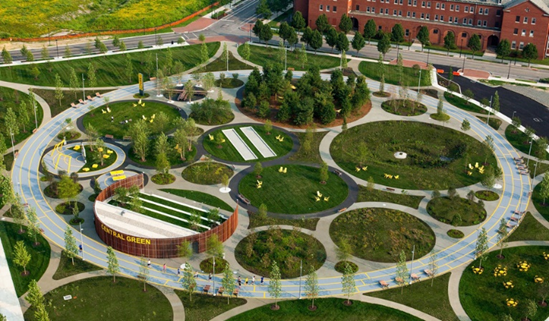
In 2015, the Dutch architectural bureau MVRDV won a competition to design a park in the very center of Seoul. A new public space was required to be created on a former flyover bridge constructed in1970. The architects had the task of making the area near Seoul Central Station, where the future more environmentally friendly, and attractive park was planned; the former motorway with a total length of 938 meters has turned into a city park, planted with various types of trees (Papenek, 2012).
The former flyover bridge is now a linear garden with 24 thousand species of plants, where the landscape changes, depending on the seasons (Galkina & Grinkrug, 2018). The city is actively connecting to the new public space, which is daily crossed by Seoul residents - new stairs and bridges from neighboring offices, hotels and restaurants are brought to the park (Miroshnik, 2017). This project of an architectural solution of a former flyover bridge and having lost its original function is an example of the "mobility" of the urban environment. Taking the change of function into consideration, the motorway was not demolished, but endowed with an idea relevant to the society - the emergence of a garden. The origin of the “green” territory became relevant and found its response among the citizens living in that place. In addition, the appearance and structure of cities is inextricably linked with water spaces. Thus, water and architecture play a significant role in the formation of a comfortable environment, architectural appearance, lifestyle of modern cities, as well as in the formation of public spaces. Water unites and separates people, it is a natural barrier and a place of attraction, and can also open up its advantages to the city (Figure 03). The organization of the environment within the water arteries is also an urgent task in recent years. The comfort of a person near the water requires architectural and design solutions. The transformation of such spaces into public involves the development and construction of embankments, the saturation of urban furniture and the formation of new recreation places for the society.
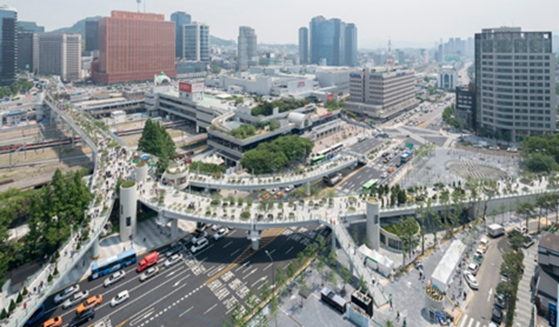
Thus, a city where there is a connection with the water area is a vector of development of many cities in the future.
The creation of a comfortable environment is one of the most pressing topics for each city, including Komsomolsk-na-Amure. The most important problem of the city is the disorganization of public spaces. Any urban space that does not have legal restrictions on accessibility can be public. The basic principle of creating a modern public space is the formation of new opportunities for the society.
At the Design of the architectural environment department of Komsomolsk-na-Amure State University, a number of works on city public spaces were developed, for example, the city of Komsomolsk-na-Amure.
Thus, with the help of the corporate identity guide of Komsomolsk, it became possible to create components of urban space that form a new look for the city.
This is shown in students’ graduation project “Elements of the design code of Komsomolsk-na-Amure in the creation of the urban landscape”, developed at the Design of the architectural environment department of Komsomolsk-na-Amure State University. Based on the theoretical materials studied, a 2-dimensional module was created, with the help of which volumetric-spatial solutions and elements of a series of harmonious and user-friendly street furniture are created for the urban environment.
The introduction of urban furniture into the public space should create an actual image of the city and its environment and meet all the requirements of comfort for different groups of the population (Figure 04).
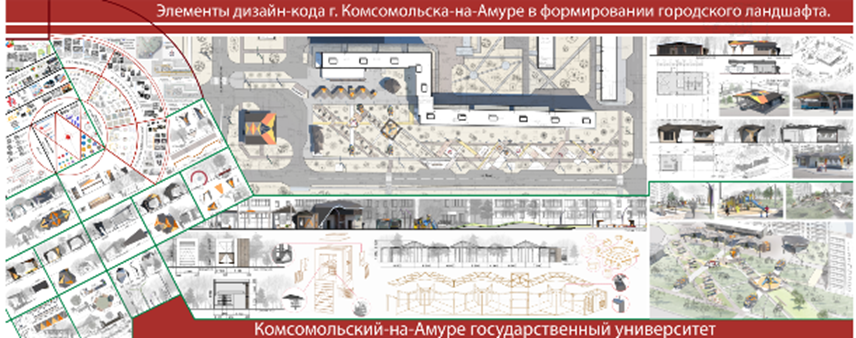
Another example shows how the brand book concept of the city of Komsomolsk-na-Amure is applied in the development of urban design objects in the organization of public space (Figure 05). So, in connection with the inclusion of the city of Komsomolsk-na-Amure in the list of priority development areas, a series of developed objects in this project provides for the possibility of placing these components in different parts of the city: squares, parks, and along pedestrian paths.
To accomplish this task, such objects as benches, awnings, a pavilion, a stopping point, ponds, information stands, ballot boxes, lanterns, and flowerpots are being developed.
One of the main tasks facing the city now is to interest the new generation in itself. That is why the visual solution when developing objects is created on the basis of expressive means presented in the brand book of Komsomolsk-na-Amure.
Therefore, the use of a single style solution in the organization of various public spaces will create a unique look of the city, which will become a kind of architectural landmark.
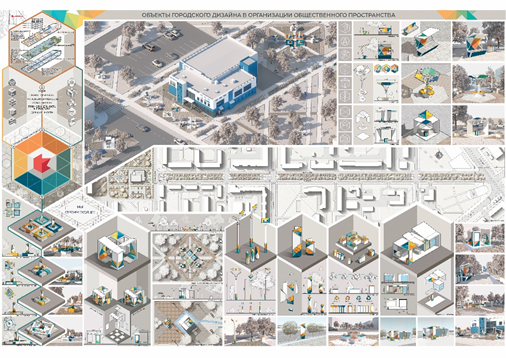
In the design solution, various means of expressing the architectural environment were used, which allowed creating a harmonious and convenient urban space saturated with playgrounds, recreation areas with awnings, skate platforms, sports areas, etc.
Conclusion
Thus, the emergence of new public spaces for the population and their further development can have a positive effect on improving the quality of the environment in the spatial and social aspect (Burdakova & Byankin, 2018). Well-maintained public spaces can become not only a place for people to relax, but also an incubator of urban development. It must be understood that public space can change local territories, become a trigger for their development - a spiritual and commercial component that can develop a whole region, provide it with an additional influx of investments, the development of economy and tourism, and become a new place of residence for the society (Landry, 2014).
It is important to note that the modern requirements of the society originate in the general structure of the world universe, which seeks freedom of movement, the generation of completely new rules for staying in an urban environment. The individual, as a part of the society, forms a responsive environment, where territories that have lost their originally assigned function acquire a new one, covered by the priority formation of urban space. Industrial, obsolete and abandoned areas are turning into spaces adequate to the present time and society (Trubina, 2011).
A set of measures aimed at the creation and development of the urban environment is gaining momentum and requires an increasing participation of administrative structures, as well as researchers of various sciences. The organization of public spaces is modeling a new city that can take into account current trends in a rapidly changing world.
References
Barke, M. (2019). Why study urban morphology? The views of ISUF members. Urban Morphology: international Seminar on Urban Form (ISUF), 23(2), 105-114.
Burdakova, G., & Byankin, A. (2018). The Research of Cluster Initiatives of a Higher Education Institution in a Priority Development Area. Proceedings of the International Scientific Conference "Far East Con" (ISCFEC 2018).
Farnaz, J. (2017). The comparison between the identity structure of the society and the physical structure of the city. Journal of Architecture and Urbanism, 41(1), 34-45.
Galkina, E., & Grinkrug, N. (2018). Edifice of architectural space developing in extreme conditions of mars, in Urban Form and Social Context: from Traditions to Newest Demands. Proceedings of the XXV ISUF International Conference, 983-89.
Gelfond, A. L. (2015). Obshhestvennoe zdanie i obshhestvennoe prostranstvo. Dualizm otnoshenij [Public building and public space. Dualism of relations]. Akademia. Architecture and construction, 2, 18-31. [in Russ.].
Grigorieva, E. M., Petrovskaya, M. V., & Gabdrakhmanov, N. K. (2018). Transition to project financing in housing construction as a new vector of urban development. Proceedings of the XXV ISUF International Conference, 931-943.
Landry, Ch. (2014). Kreativnyy gorod [Creative city]. Moskow: Klassika - XXI. [in Russ.].
Miroshnik, L. (2017). Top-7: Novyie parki mira [Top 7: New parks in the world]. https://www.elledecoration.ru/interior/outdoor/top-7-novyie-parki-mira/ [in Russ.].
Papenek, V. (2012). Dizayn dlya real'nogo mira [Design for the real world]. Moskow: Aronov. [in Russ.].
Pari, R. (2017). Expanding the boundaries of architectural representation. The Journal of Architecture, 22, 815-824.
Sullivan, L. (2017). Chto takoye sovremennoye obshchestvennoye prostranstvo [What is modern public space]. https://monogoroda.info/uploads/knowledge_file/content/11/2_1_Monotowns_Presentation_Revzin.pdf [in Russ.].
Trubina, E. G. (2011). Gorod v teorii: opyty osmyslivaniya prostranstva [City in theory: experiments in comprehending space]. Novoye literaturnoye obozreniye. [in Russ.].
Copyright information

This work is licensed under a Creative Commons Attribution-NonCommercial-NoDerivatives 4.0 International License.
About this article
Publication Date
21 June 2021
Article Doi
eBook ISBN
978-1-80296-110-2
Publisher
European Publisher
Volume
111
Print ISBN (optional)
-
Edition Number
1st Edition
Pages
1-1168
Subjects
Social sciences, education and psychology, technology and education, economics and law, interdisciplinary sciences
Cite this article as:
Grinkrug, N. V. (2021). Public Space Creation As A Way Of Forming Modern Urban Environment. In N. G. Bogachenko (Ed.), Amurcon 2020: International Scientific Conference, vol 111. European Proceedings of Social and Behavioural Sciences (pp. 363-371). European Publisher. https://doi.org/10.15405/epsbs.2021.06.03.49

